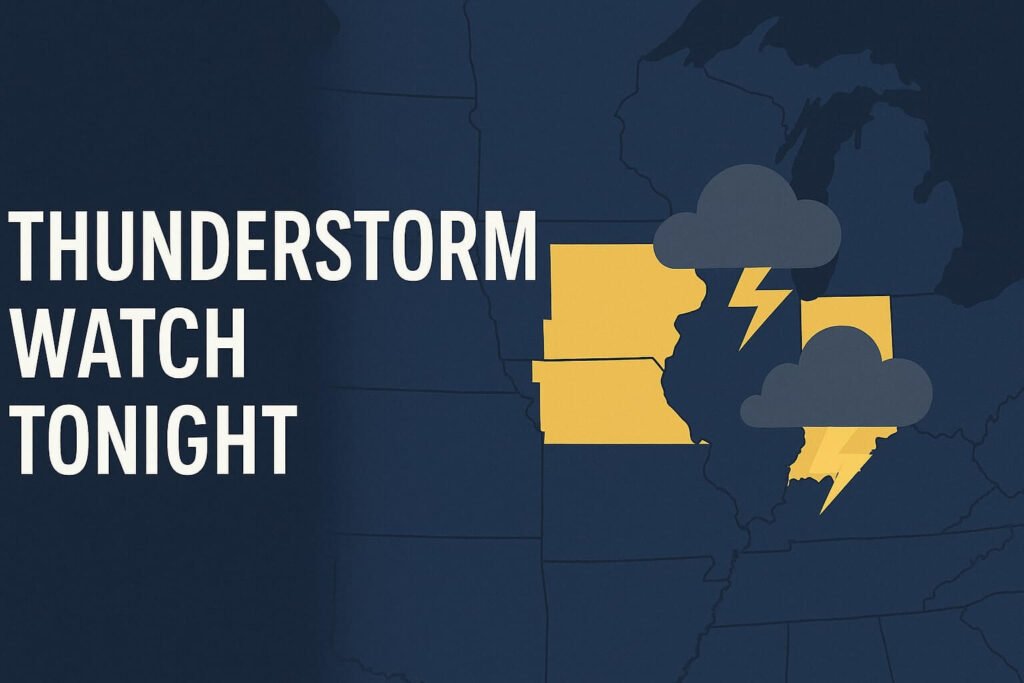From scattered hailstones in New England to fire-starting winds in Maryland and dust-shrouded skies near Las Vegas, the atmosphere isn’t sitting still tonight. A thunderstorm watch has been issued for parts of the High Plains, and although other regions have recently seen their watches expire, the wake of that weather is still felt from coast to coast. So what exactly does it mean when a thunderstorm watch is active, and what should you do when one pops up on your radar? This isn’t just about flashing graphics or yellow zones on a map, it’s about the signals the atmosphere is sending, and how fast those signals can flip from harmless to hazardous.
Right now, the most urgent focus is in the western and central U.S., where Watch 482 remains active through the late evening. This area spans portions of northeastern Wyoming, western South Dakota and western Nebraska, including regions just north of Rapid City and east of Sidney. Issued by the Storm Prediction Center (SPC), this thunderstorm watch outlines a clear threat: hailstones up to 2 inches across and wind gusts possibly reaching 70 mph. Those aren’t soft breezes and light sprinkles, they’re roof-damaging, windshield-cracking forces that can take down power lines and bring tree limbs crashing into roadways.
If you live in these areas or anywhere along the active storm corridor tonight, now is the time to double-check your emergency alerts, move your vehicle under shelter and bring in anything from the yard that could take flight. The SPC meteorologists are particularly concerned that a couple of rotating storms – high-based supercells, as they call them – could form and then join forces into a larger storm complex. That’s a recipe for long-lasting damaging winds and intense lightning.
Meanwhile, the Mid-Atlantic just wrapped up its own evening thunderstorm watch, which expired around 9 p.m. local time. That one had some teeth. It stretched from Washington, D.C. through Baltimore, up to Philly, and into New Jersey. Even before the watch expired, the damage was already done: thousands without power in parts of Maryland, a house fire started by downed powerlines in Rockville, flash flooding warnings blinking across mobile devices. This kind of impact shows how critical it is to take a thunderstorm watch seriously, even when skies are blue at the moment you hear about it.
Earlier today, New England also caught a taste of severe weather. Towns in Worcester and Norfolk Counties in Massachusetts were put on alert as dark clouds moved in, backed by wind gusts and hail cores strong enough to ping off windshields and strip early summer leaves from trees. Radar returns around Uxbridge even hinted at hail up to 1.5 inches, showing how these systems can surprise even in traditionally calmer regions.
Out west, Las Vegas wasn’t under a thunderstorm watch, but storms still managed to kick up enough dust and gusts to rattle windows and plunge neighborhoods into brief darkness. A 45 mph gust front swept through Clark County, leaving more than 10,000 customers without power. In the desert, a fast-moving storm can flip from beautiful to blinding in minutes, especially when it kicks up a haboob – a type of dust storm common in arid zones.
All these events, scattered as they are, tie back to the larger pattern shaping the atmosphere this week. A dip in the jet stream, known as a mid-level trough, is currently gliding eastward across the Great Lakes region. It’s not a dramatic, sweeping system, but it’s enough to tug a cold front through the Mid-Atlantic and energize a belt of strong upper-level winds. When you combine that with dew points in the 70s, daytime heating that pushes surface temps into the 90s and modest wind shear, you get a juicy setup for strong to severe storms.
In the High Plains, the energy is slightly different but no less potent. Here, steep lapse rates – a fancy way of saying the air cools rapidly with height – mix with rich surface moisture and just enough wind support to build towering, hail-producing supercells. These kinds of storms often start solitary and sculpted, then evolve into sprawling clusters that race across open prairie, chewing up fields and fence lines as they go.
So what should you do if your area falls under a thunderstorm watch? First, remember the difference between a watch and a warning. A watch means that conditions are favorable for severe storms – it doesn’t guarantee that your neighborhood will be hit, but it means the ingredients are coming together. A warning, on the other hand, means it’s already happening or about to happen nearby.
When a thunderstorm watch is issued, take a few quick steps:
- Charge your devices in case the power goes out
- Secure or bring inside any outdoor furniture, umbrellas or loose items
- Move vehicles into a garage or under shelter, especially if large hail is possible
- Stay off water if you’re boating or fishing – gust fronts can arrive before the rain
- Monitor trusted weather apps or NOAA radio for updates every 15–30 minutes
Tonight, as we transition into the overnight hours, the threat won’t vanish. The SPC keeps a Marginal Risk outlook alive from Minnesota through parts of Idaho, meaning isolated damaging wind gusts or small hail could persist into the early morning. A strengthening low-level jet – fast-moving winds a few thousand feet above the ground – could help storms hold together longer than they usually would after dark.
Looking ahead into tomorrow, storm energy reloads across the northern Rockies and the Upper Midwest. A new thunderstorm watch or two might light up the radar by mid-afternoon, especially from eastern Montana through central Minnesota. These aren’t just pop-up showers, they’re organized systems driven by synoptic-scale energy and real-time atmospheric ingredients. If you live in that zone, keep your alerts on and eyes on the sky.
Thunderstorm watches serve as our earliest formal heads-up. They don’t mean panic, they mean prepare. The real challenge is how quickly things can escalate. What begins as a distant rumble can, in 20 minutes or less, become a blinding squall with sideways rain and hail that eats through windshield glass. With summer heat building and jet stream patterns swinging widely, July evenings like this can flip the switch from peaceful to powerful in a heartbeat.
So wherever you are tonight – from the breezy New England hills to the shadowy plains of Nebraska – take each watch seriously. Use it as a moment to pause, reassess and reconnect with your safety plans. The air around us may be shifting fast, but staying informed gives you the edge to stay safe, no matter how stormy the night becomes.


